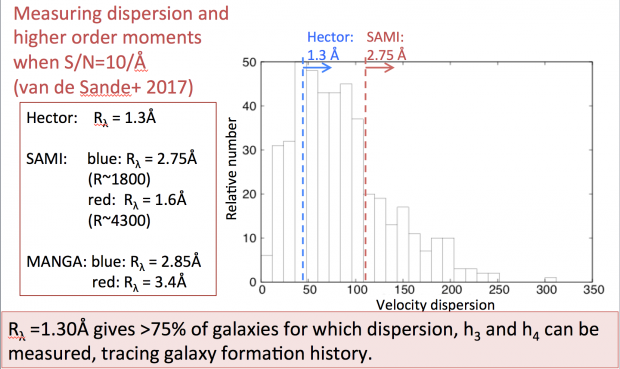Overview
Overview of the Hector Instrument and Survey

The Hector Instrument and Science Teams
You can find the team members via the following links:
The Hector Instrument
Hector is the next major dark-time instrument for the AAT and is a multi integral-field-unit spectrograph aimed at obtaining a low-redshift galaxy survey of 15,000 galaxies, with an aim for >70% imaged out to 2 effective radii.
Hector will decipher the diversity of galaxies through understanding the physical basis for their individuality.
The key science questions for this instrument include how do galaxies build up mass and angular momentum, how is star formation and nuclear activity affected by environment, what is the role of feedback, and how does large-scale environment modulate galaxy growth through tidal torques and gas accretion.
Hector will be built in stages and the first stage called Hector-I is under construction.
Hector I
Will employ the first new Hector spectrograph (blue and red arm) alongside the existing AAOmega spectrograph. Both will be fed with new-generation hexabundles. The higher resolution Hector spectrograph will have 11 x 61-core (15 arcsec diameter) and 1 x 91-core (18 arcsec) hexabundles. AAOmega will host the largest hexabundles with 3 x 61-core, 1 x 91-core, 1x 127-core, and 2 x 169-core (27 arcsec diameter). An additional 37-core hexabundle on each spectrograph will observe a star for calibration.
Hector spectrograph – Higher resolution 1.3Angstroms from 372.7-776.1nm
- R~3800 @ H-beta/[OIII]
- R~5000 @ Halpha/N[II]
AAOmega – Lower resolution R~1700 blue, R~4500 red.
•A new robotic system will position magnets across the field plate which will rotate the hexabundles in 3 axes to match telecentricity and ferule positioning, which will improve throughput over the existing 2dF facility. Observers will put the configured plate onto the telescope and attach the 21 hexabundles. One plate can be being configured by the robot while another is observing.
•Science operations by mid-2021.
•Offers significant science gains over SAMI with increases in survey speed, galaxy coverage to 2 effective radii for ~70% of galaxies and higher spectral resolution.
•Will deliver the only IFS survey large enough to connect galaxy evolution and kinematics to large-scale-structure to explain the evolutionary history leading to individuality of galaxies.
Hector science target regions will be chosen within the future WAVES Survey footprint where significant auxilliary data will be available. In addition clusters will be selected to add the highest halo masses. The TAIPAN survey will be used for redshift selection in the WAVES regions.
Currently funded.
Hector II
•Would be a future extension of Hector-I by adding new modules. Each module is one Hector spectrograph (blue and red arm) plus 10 new larger hexagonally-packed hexabundles with up to 217 fibre cores each.
•Allows a faster survey speed and higher fraction of galaxies imaged to 2 effective radii.
•Modules will be added as funding becomes available. Currently not funded.
Table Summary
| SAMI | Hector-I | Hector-II | |
|---|---|---|---|
| Number of hexabundes | 13 | 21 | 51 |
| Field dimameter (degrees) | 1 | 2 | 2 |
| Coverage diameter on each galaxy | 15" | 15-28" | 15-30" (2Re on 90% of galaxies) |
| Survey size | 7100 | 15000 | >30000 |
| Cost | $0 | $5M | $15M |
Science Requirements Definition
After extensive astronomical community consultation on the needs for Hector, the science case for the Hector Survey and the requirements for the instrument were defined.
The Science Requirements document outlining key science and the resulting instrument specifications for Hector can be found here
Hec Spc 001 Science Case Document V 1 0 Signed
The key niche for Hector is the combination of high spectral resolution and large survey size.
This allows unique science on stellar kinematics and deblending emission-lines that can only be done with this combination of specifications.
The stellar kinematics science case aims to measure higher order moments (h3, h4) to link the kinematic tracers to simulations of galaxy merger histories. This is a priority science case for Hector because Hector will be the only instrument in the world that can do this. The reasons are that the higher spectral resolution enables the h3 and h4 lines to be measured in 75% of our galaxies to S/N=10, whereas in SAMI, only ~26% of galaxies will accurately have these measures. For Manga it will be fewer still because the spectral resolution is not as good as SAMI and therefore Hector will be the only large galaxy survey capable of this science. The link between kinematics and galaxy merger history is unique, and is crucial to our understanding of galaxy evolution.
Spectral resolution comparison

Figure: The histogram shows the typical range of velocity dispersions for galaxies in the Hector Survey. The high spectral resolution of 1.3 Angstroms allows all galaxies to the right of the blue dashed line to have their higher order stellar kinematic components (h3 and h4) measured with a S/N=10/Angstrom. This can only be done for fewer galaxies in the SAMI survey (red dashed line) and even fewer in Manga, because the spectral resolution is lower. 75% of the 30,000 Hector galaxies will have measurable h3 and h4.
The high spectral resolution is a significant advantage for the emission line galaxy science because it will enable deblending of multiple line components. This will enable identification of winds and outflows, and separation of AGN processes at a level not previously possible with existing IFU surveys.